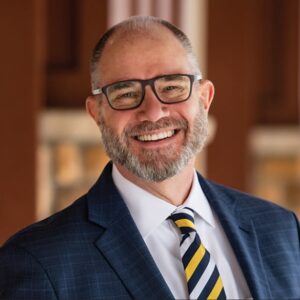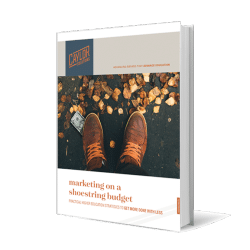How to Choose the Best Digital Marketing Agency for Your School
Learn how to select the ideal digital marketing agency for your school by weighing size, location, and specialization to drive real results.
Featured
In higher ed leadership today, we face mounting challenges that don’t seem to be going away.
Low enrollment numbers, tighter budgets, struggling student outcomes, and the constant concern of financial instability—all these issues weigh heavily on our institutions.
If this feels familiar, you’re not alone.
Many schools find themselves scrambling to meet these demands, trying to maintain their missions while navigating an increasingly competitive landscape.
Across higher ed, we’re realizing that our traditional, nonprofit mentality may need a serious overhaul.
What if the key to turning these challenges around lies in changing our mindset from a strictly nonprofit approach to one that aligns with the best practices of a CEO?
Imagine running our institutions with the same precision, accountability, and growth-oriented thinking that a successful business employs.

Of course, this is not about abandoning our values or our commitment to student success but about transforming the way we think and operate.
In this episode of The Higher Ed Marketer podcast, Eric shares how this business-driven approach can align with the mission of higher ed institutions while promoting financial sustainability.
From focusing on net tuition profits to involving donors as partners, Eric demonstrates why universities must embrace financial transparency and innovation to thrive as they approach the enrollment cliff.
With a robust career in the corporate sector, Hogue is no stranger to efficiency, profitability, and growth strategies.
He approaches higher education with a similar zeal, emphasizing the importance of running a Christian university like a sustainable business.
Unlike many traditional academic leaders, he champions profitability within each operational division.
“I view each area of our university—whether it’s residential, online, or dual credit—as separate business units. Each must be profitable independently to ensure the entire institution’s sustainability,” Hogue explains.
Hogue’s model bucks the trend of allowing more profitable divisions to cover shortfalls in others, advocating instead for self-sustaining growth across all areas.
I said each division has to be profitable within itself.
[Many were shocked and responded] “Well, why can’t online just make all the money? Online courses are the cash cow that brings the money in while you drive a loss in traditional residential [programs].”
I’ll give you one answer: It is not sustainable!
There will be a day where [one or both programs fail to perform]. You need to be profitable in both, or in our case, all three divisions.
His goal? To protect CCU’s mission without sacrificing financial health—a challenge many universities are currently grappling with as they face increasing economic pressures and demographic shifts.
How did Eric win over his staff to begin thinking this way?
He shared his heart with them concerning how he wanted them to do well too.
“You all deserve a really good paycheck. You deserve great benefits. You deserve promotions and incentives,” Eric shared with his staff. “And in order to do that, the university must make a profit year after year after year.”
For Hogue, sustainable fundraising means treating donors as strategic partners rather than cash sources for operational expenses.
He urges institutions to reserve philanthropy for transformative projects and endowment growth rather than immediate financial needs.
“Stop relying on philanthropy to keep the lights on,” Hogue advises. “Instead, we need to engage donors as investors in our mission, asking them for advice and perspective rather than simply funding.”
This approach not only strengthens donor relationships but also aligns financial resources with long-term goals.
He emphasizes “friend-raising” over fundraising, developing lasting connections that are rooted in shared values and purpose.
By adopting this perspective, CCU has been able to build a strong network of advocates who support the university’s mission-driven goals.
A core principle of Hogue’s philosophy is that universities must clearly define and consistently communicate their unique identity.
CCU’s distinctiveness lies in its conservative, Christian mission, and Hogue has no qualms about firmly establishing that identity.
He believes this clarity is vital for attracting mission-fit students, faculty, and donors.
“Our goal is to be the nation’s best-performing, most trusted, and recognized Christ-centered university,” Hogue says. “We’re not for everyone, and that’s okay. But we stand firm in our values, and that has brought us the right supporters.”
Hogue’s strategy of “putting a flag in the ground” aligns with his broader CEO mindset.
By being unapologetically clear about CCU’s identity, he ensures the university stands out in a crowded landscape where many institutions struggle with vague or diluted messaging.
Hogue’s approach to higher ed leadership extends into long-term financial planning, which he views as essential to facing the “enrollment cliff” and evolving competition.
At a key point in our talk, Eric stressed that higher ed leadership should have a realistic and strategic view of tuition price elasticity to help keep our institutions from overly relying on philanthropy for operational costs.
[A top priority] would be price elasticity, what your tuition price is and what your discount rate is. You have to come to a conclusion that there is a price elasticity that fits your enrollment geography or characteristics like geography, mission, denominational, maybe your gpa, your brand or how compelling and distinct you want to be.
You need to determine your price elasticity and attach it to a three year staircase.
I’ll be honest. Last year at CCU, we went up 5%, down 5% of the discount rate because we believed that we could enroll the same number once again and it created more margin.
With price elasticity, you don’t want to be hung up on a record enrollment and the numbers at the top of the scale. You don’t want to drive your discount rate.
You don’t want your discount rate at 65% or 68%. You want it right around 48%, and you want to hold it there and you want it blended all the way through.
Essentially, Eric pointed out that each institution has a “sweet spot” for pricing—one that takes into account the unique characteristics of the school’s geography, mission, and target student demographic.
Price elasticity in this context refers to how sensitive potential students are to changes in tuition costs.
Hogue suggests that by finding a price point that resonates with the school’s target demographic (like mission-fit students or those from certain geographic areas), the institution can attract students who are both likely to enroll and find value in the school’s distinct offerings.
For example, if the school has a strong denominational or mission-driven appeal, as Colorado Christian University does, this could make certain students less sensitive to higher prices if they feel a strong alignment with the school’s values.
Alternatively, for students who are more price-sensitive, Hogue might consider adjusting tuition or discount rates to make enrollment more feasible.
I agree with Eric that if we can learn to think more like a business CEO, these conversations will help us make better, more sustainable decisions.
Adopting a CEO mindset in higher ed leadership isn’t for the faint of heart.
For leaders willing to take the leap, Hogue emphasizes the need to make tough decisions with courage and clarity, from program cuts to staffing adjustments.
His advice to other higher ed leaders?
Begin by aligning with your board, setting a clear, long-term vision, and embracing candid discussions about sustainability and mission.
“Higher ed is a business,” Hogue states plainly. “To ensure our mission endures, we need to prioritize stewardship and make bold moves. And that sometimes means making difficult decisions for the greater good.”
If you want to learn more, listen to our full interview with Eric Hogue to get even more insights into:
Then you should definitely check out our Enrollment Assessment service at Caylor Solutions!
Our evaluation service analyzes your institution’s existing enrollment processes and strategies, pinpointing areas for improvement and opportunities that you could take greater advantage of.
Together, we’ll take a look at your admissions workflows, communication tactics, prospective student engagement methods, and retention strategies.
In the end, we’ll give you a clear path forward with specific, actionable recommendations aimed at boosting enrollment numbers, improving student retention, and enhancing overall student satisfaction.
Ready for clarity and insights that will help you drive enrollment? Contact us today!
Set yourself free from your shrinking marketing budget with my popular ebook Marketing on a Shoestring Budget! This ebook is jammed with practical ways to produce high-quality marketing on the cheap.
Inside, I’ll show you proven marketing tactics like…
No hype. No pie in the sky. Just real solutions for getting the job done with the budget you’ve got.
Featured image via ccu.edu
Subscribe to The Higher Ed Marketer podcast today!